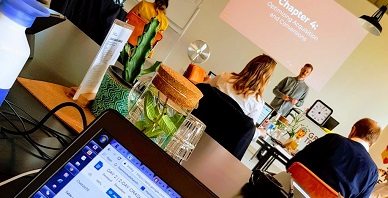Is agility the NEW creativity?
In our complex world, we all need to be AGILE! We need to have mental agility in order to cope with all the management and marketing challenges. As marketers, we need to be both creative and agile at the same time. But how do we boost our creativity? How can we learn to consciously trigger our agility? In this series of blogs, I want to share my experience and learnings that I personally apply on a daily basis. In this first blog, I will focus on the importance of escaping from your engrained thinking patterns; in the second blog, I will explain some brainstorming techniques and, in the third one, the need for a creative environment and process will be discussed.
Lateral thinking is mental agility
 When I thought about the meaning of mental agility, it reminded me of lateral thinking, which Edward de Bono explained to me in the 1990s. His serious creativity course was a life-changing experience for me, as, from that day onward, I started to consciously train myself to escape from the mainstream.
When I thought about the meaning of mental agility, it reminded me of lateral thinking, which Edward de Bono explained to me in the 1990s. His serious creativity course was a life-changing experience for me, as, from that day onward, I started to consciously train myself to escape from the mainstream.
To be able to survive and make quick decisions, we structure every piece of information into a logical order; a flow, a path, a stream. The more assured we are that this flow of reasoning suits “our survival”, the more it becomes a “main stream”. Like rain falling on a forest, it will create its streams. These streams that are ingrained in our mind represent the beginning and end of who we are and how we think. They form our mental models. At some point, these streams become so deeply ingrained, that we even start to force new information packages into these existing patterns. We become rigid and narrow-minded.
Mental agility = mental escape = open mind
Forbidding the use of the platitudes “this is not new, we tried it in the past, it did not work”, I force myself to escape from my main streams. I personally use two instruments for this; associations and the provocation technique of de Bono (although I still find it difficult to use the word PO!)
Associations and idea generation
Fortunately or unfortunately (depending on your mental model), I automatically connect and associate. This allows me to make all kinds of strange connections, sometimes triggered by colors, smells, shapes or words. For me, an associative mind is an eternal joy. The easiest way to explain or train yourself in associative thinking is by flipping back and forth between “idea and concept”. Let me give you an example:
From apple to smog in five steps
 Assuming that an apple is our starting idea, what possible underlying concepts come to mind when thinking of an apple: an apple is a “fruit”; “round (shape)”; “green (colour)”.
Assuming that an apple is our starting idea, what possible underlying concepts come to mind when thinking of an apple: an apple is a “fruit”; “round (shape)”; “green (colour)”.
The next step is to take a concept and start associating it with new ideas. From the “concept” of fruit, we ideate bananas, orange, grapefruit, kiwi, etc. Other “round shapes” may lead to a ball, a traffic sign, a coin. New “green objects” could be a crocodile, grass, etc. This allows you to associate, generate, and move from an apple to smog in only five steps. With each step you create another association and think of the underlying concept.
Apple (green)
Crocodile (green and animal)
Cheetah (animal and speed)
Tesla (speed and energy saving)
Solar panel (energy saving and Chinese)
Smog (Chinese and pollution).
This principle will also work in the business environment. Let’s assume that we are brainstorming around the challenge of “how to grow our business”. One of the ideas could be “get more customers”. One of the underlying “concepts” of customers is “parties that pay for our products & services”. If we think of other parties that would be willing to pay for our activities, we may think of research institutions that also need quality control (one of the services we sell to customers). A similar way of thinking with another underlying concept of “more customers” may lead to “multiplication” (more). What other activities could we multiply? Maybe the number of sales people?
Provocations to escape
De Bono encourages us to use a provocation– a statement that we know is wrong or impossible – to start the ideation of new thoughts. To ensure that people are not doubting your sanity, you should start the provocation sentence with “PO”. SCAMPER (by Bob Eberle, based on the checklist by Alex Osborn) is a way to remember the types of provocations (see the movie: https://www.youtube.com/watch?v=G8w0rJhztJ4). Combine it with de Bono’s movement technique, and serious creativity is born.
SCAMPER
S = substitute a component in your existing business by something else. PO; we will let our customers pay for the service and get the product free.
C = combine or assemble with other attributes or components. PO; we will sell yogurts that can be prepared in the microwave.
A = adapt it for other purposes. PO; our solar panels can be used to predict the weather.
M= modify the shape, look or feel of your product, minimize/maximize. PO; our free-flowing powders will be sold as solid rocks.
P = put to another use, somewhere else, perhaps in another industry. PO; we will develop solar panels that can be used as surfboards.
E= eliminate certain parts. PO; we will sell our vitamins without a package.
Movement Techniques
Once you have a PO statement and start the brainstorming, associations can be used to come up with further creative ideas. Another way is to use “movement” to stimulate creativity and idea generation. Examples of “movement” are:
- Focus on the difference; what is different from the current situation
- Look at the moment-to-moment effect of putting the idea into practice
- Focus on the positive aspects
- Figure out under what circumstances there would be immediate value
GET SERIOUS on CREATIVITY
We can all be creative. It is a matter of escaping from your ingrained patterns of thinking, and using associations and provocations to help you generate new ideas. De Bono is a great inspiration to learn from, and I still use and would recommend the following books; Lateral Thinking and Six Thinking Hats. Get serious!
In the next blog, I will explain two techniques that will help you think outside the box.
* this is the first blog in a series of three on serious creativity.

![]()







 When I thought about the meaning of mental agility, it reminded me of lateral thinking, which Edward de Bono explained to me in the 1990s. His serious creativity course was a life-changing experience for me, as, from that day onward, I started to consciously train myself to escape from the mainstream.
When I thought about the meaning of mental agility, it reminded me of lateral thinking, which Edward de Bono explained to me in the 1990s. His serious creativity course was a life-changing experience for me, as, from that day onward, I started to consciously train myself to escape from the mainstream.